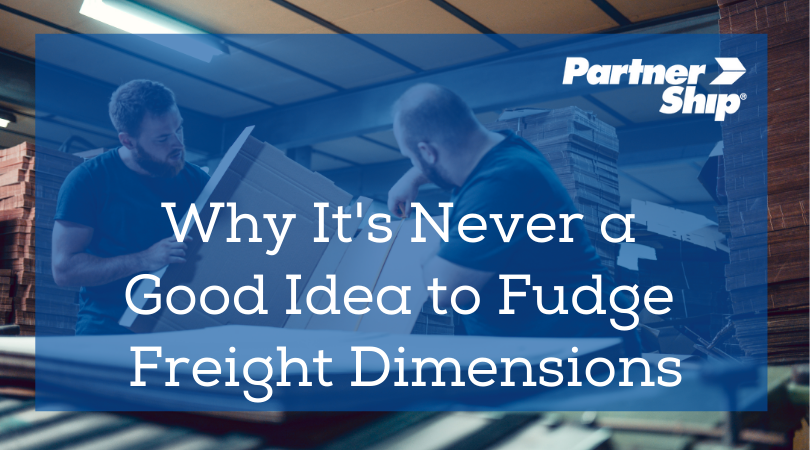the PartnerShip Connection blog
the PartnerShip Connection blog
the PartnerShip Connection blog
the PartnerShip Connection blog
the PartnerShip Connection blog
-
Asset vs. Non-Asset Based 3PLs: The Major Distinctions
01/21/2021 — Leah Palnik
There are two main types of third-party logistics (3PL) providers and they’re not exactly created equal. Asset based 3PLs and non-asset based 3PLs each have their place in the market. However, they have a few key differences that can impact how your freight is handled and how much it will cost you.
What are asset based 3PLs and non-asset based 3PLs?
Asset based logistics providers own some or all of the parts of the supply chain. This can include carriers, trucks, warehouses, or distribution centers. Conversely, non-asset based 3PLs don’t own these parts of the supply chain. Instead they are relationship-based and develop a network of partners to help move your freight.The major differences between asset based and non-asset based logistics
Besides how they operate, there are some distinctions that are important for shippers to take note of.- Flexibility and ability to offer custom solutions
Since asset based 3PLs have their own carriers, those are the carriers they will rely on to move your freight. Their carriers likely specialize in specific lanes or services or may only have a presence in one part of the country. If those specializations match up with your specific needs, it could be a great partnership. However, if they don’t or if your needs vary, you likely won’t be receiving the most efficient or cost-effective service.
On the other hand, non-asset based logistics providers have a wider network. They have access to multiple carriers which allows them to source the one that most closely aligns with your needs. That flexibility allows them to offer more customized solutions for your freight. - Level of control over the supply chain
Asset based 3PLs have more control over the supply chain because they own the assets that comprise it. What that results in is the ability to set their own pricing more easily because they don’t have to negotiate with an outside party. Asset based 3PLs also have more direct control over carrier issues and errors. They can implement changes with their carriers that non-asset based 3PLs simply can’t.
Non-asset based 3PLs have less control, especially when it comes to what the carrier does. That’s because there are more hands involved with moving your freight. However, a quality broker will know what to look for to prevent issues and will have high standards for the carriers it keeps in its network. - The underlying interests of the 3PL
It’s hard to argue that asset based 3PLs aren’t inherently biased. They own their own warehouses and trucks, so it’s obviously in their best interest to have shippers use them over others.
The interests of a non-asset based 3PL are more in line with the shipper than the carrier. The best brokers will work on your behalf to find discrepancies in your invoices, provide claims assistance, and use their expertise to help you ship more efficiently.
How to decide between an asset based 3PL and a non-asset based 3PL
The type of 3PL that is best for you will largely depend on your specific needs. In general, you want to make sure you are working with a broker that can get you access to capacity when you need it most. From there, you should evaluate the typical characteristics of your freight so you can find a 3PL that is closely aligned.No matter the situation, you need to work with a quality broker that is dedicated to finding you the freight solutions you need. PartnerShip is a non-asset based 3PL with an extensive network of alliances designed to help you ship smarter. Contact us to learn how you can save on your freight and improve your operations.

Click to read more... - Flexibility and ability to offer custom solutions
-
Why It's Never a Good Idea to Fudge Your Freight Dimensions
01/12/2021 — Jen Deming

While constancy isn’t something you can always expect in the freight industry, there are a few steady trends we’ve seen in recent years: less truck availability, an oversaturated network, and rate increases. Both sides are using tactics to offset these variables. Carriers increase fees, and in response, shippers explore means to cut costs. A trend we’ve seen among novice and experienced shippers alike is either estimating or downright falsifying the freight dimensions and weight of their LTL shipments. But, we’re here to tell you that going either route is a risky maneuver that can have major fallout.
Incorrect dimensions can delay your shipment
Carriers have an entire arsenal of tools at their disposal that check for discrepancies in weight and freight dimensions. Once LTL shipments are picked up and the BOL (bill-of-lading) is tendered to the carrier, that paperwork serves as a legal document — a contract between the shipper and carrier. Because LTL shipments stop at multiple terminals while in transit, there is plenty of opportunity to get “caught” if your weight or freight dimensions stated on this document are incorrect. If a carrier suspects misrepresentation on a BOL, intentional or not, your shipment will be flagged for an audit and an inspection. This process takes some time and your shipment will be detained. Depending on the volume going through that particular terminal, it’s tough to say how long that could be. Your shipment delivery will likely be delayed or missed, which can be a disaster if it was a time-sensitive shipment or if it holds up other operations for you or your customer. It’s just not a good look.
You could be subject to reweigh, reclass, and over-dimensional feesAs outlined specifically in each carrier’s rules tariff, freight rates are determined on a variety of variables. When it comes to weight, cost is often calculated on a per pound basis and a maximum “standard” shipment length. Intentionally underestimating weight and size in order to save money can be tempting. However, if the actual weight and length is determined to be more than stated on the provided BOL, the final cost will be adjusted to reflect that. But, how much can that really be, right? If you’re still thinking about estimating your freight dimensions, think again: fees associated with these inaccuracies can affect your bill twofold.Firstly, the audit and subsequent reweigh or measurement will incur an inspection fee. The standard inspection itself can cost anywhere from $20 to $50 for weight changes. According to their rules tariff, UPS Freight charges $25 for a reweigh. As for restricted lengths, the fee can vary greatly by carrier and is often calculated on a cost per foot basis. For example, UPS Freight charges $90 for “extreme length” LTL shipments that fall within 8-12 feet. Larger than that, but under 20 feet can cost you $125. Of course, it increases incrementally from there.Secondly, changes to your shipment details may affect your freight class, another important component of your freight rate. Some types of products are classed based on density breakdowns; a dimensionally-large but lightweight shipment can be expensive. If your weight is incorrect, your density and class may change significantly, which will affect the overall cost of your shipment. Combined with the initial fee, these two factors can ultimately tack on hundreds of dollars in unexpected fees alone — in fact, they may add up to more than the original cost of your load.False freight dimensions can lead to disappointing claim payoutsSo let’s talk about another worst-case scenario: your freight shipment is damaged or lost while in transit. It’s a daunting prospect, but unfortunately, a pretty common occurrence, especially as more freight enters the network. Most shippers know that in order to recoup losses, you can always file a claim with the carrier. But payouts can be complicated, and what many shippers don’t know is that a final claim payout can be majorly affected if the provided shipment details are inaccurate.Most carriers determine claim payouts on a dollar per pound basis, with heavier shipments receiving higher payouts. Even if your dimensional fudging makes it past the carrier unnoticed, a payout based on these inaccurate details may be much less than what you were hoping for. To make things even more complicated, certain classes of products aren’t covered at all. If the carrier does find out you inaccurately disclosed weight, dimensions, or other details, the claim can be completely denied.How to ensure you have accurate dimensions for your freightWhile it’s clearly not a great idea to guess or fabricate your freight dimensions, mistakes can also be made when you have the best intentions of providing the correct measurements. There are a few tips you should follow to ensure the details of your shipments are as accurate as possible.- Invest in quality scales and other tools used within warehouses
- Audit and calibrate your measurement tools regularly
- If you aren’t able to acquire the proper equipment, use the manufacturer’s specs
- Don’t forget to add in weight and size measurements from packaging such as pallets, cartons, etc.
- Always calculate proper freight density
- If you are receiving the freight shipment but are responsible for the shipping costs, make sure those details are being calculated accurately
Shippers are always going to be looking for ways to cut transportation expenses in order to improve their bottom line. While shipping costs may be a flexible area for that opportunity, fudging your freight dimensions to get there is both unethical and extremely risky. If you’re stuck on how to save, PartnerShip can help.Inaccurate freight dimensions is just one of the common slip-ups shippers make that have costly consequences. Check out our free guide on the top 5 most common mistakes to avoid so you can ship smarter.
Click to read more...




